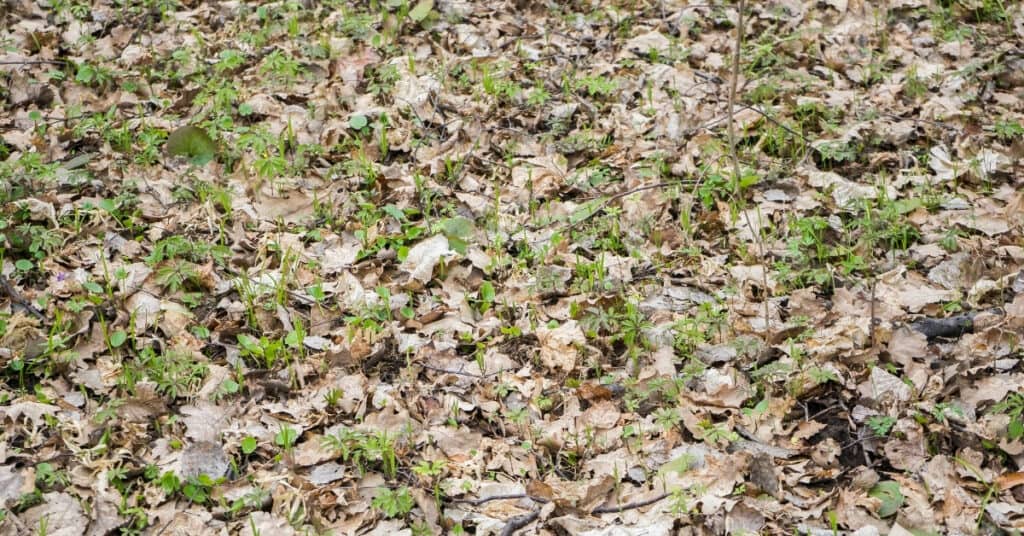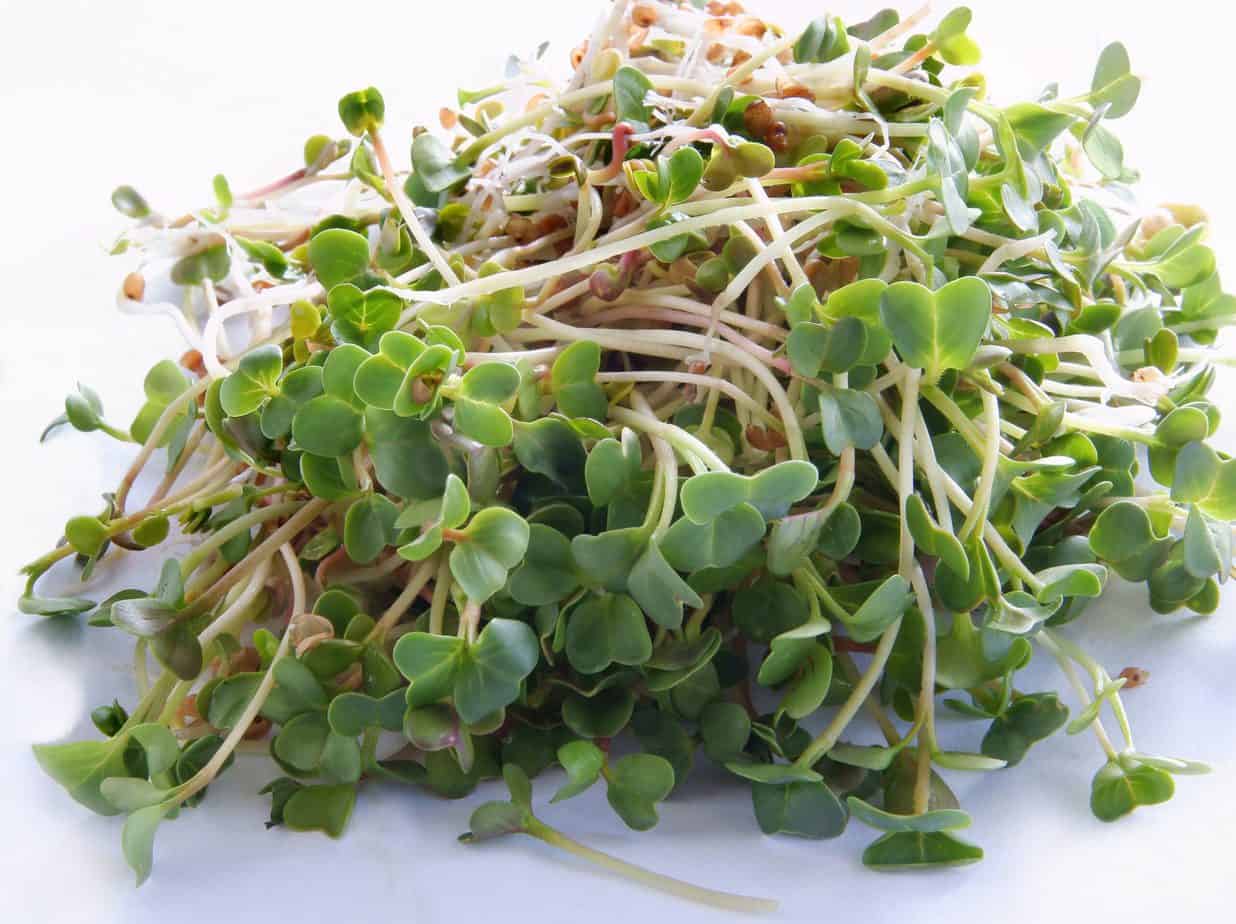Dehydrating microgreens, fruits and vegetables keep extra food from spoiling while maintaining nutrients. Dehydrating has been practiced for thousands of years among various civilizations to have food year-round and consume all food that is produced. When growing microgreens, dehydrating allows you to take advantage of their nutrients and add flavor to food.
It is a FACT that you can dehydrate and dry microgreens. Dehydrating can be achieved with an oven, food dehydrator, or the sun. All methods will allow the moisture to be removed while still maintaining the high concentrations of nutrients in the microgreens. Dehydrated microgreens provide you with long-lasting vitamins and minerals for a range of recipes.
With the range of methods to dehydrate microgreens, you can do so in small or large batches with the most significant cost efficiency as well as the amount you may need or want for specific recipes and uses. Dehydrating adds more versatility to your meals and prevents nutritious food from going to waste after harvest.
Can You Dehydrate or Dry Microgreens?
Microgreens can be easily dried or dehydrated because they are small, and there is not much moisture to begin with (at least compared to many fruits and vegetables that are commonly dried).
Dehydrating microgreens can be completed in various ways, allowing you to do so with varying equipment. It also provides excellent benefits for health and well as food preservation.
Methods for Dehydrating Microgreens
Microgreens can be dehydrated or dried similarly to most fruits and vegetables, with some considerations for “cook” time.
Regardless of the drying method, some common steps need to be taken before, during, and after the drying process to reach desired outcomes.
For all drying methods, you should do the following for best results:
- Stem removal: Remove stems so that only leaves remain. It is okay to leave a little in order to protect the leaf, which can always be removed after drying. When you remove the stems, you are also allowing for more space to be dedicated to leaf moisture removal.
- Wash your microgreens: All dehydrated greens should be washed beforehand to remove any dirt or potential contaminants from being outside (Source: K-State). You will want to make sure you dry off excess water to make the dehydrating process more effective.
- Single-layer drying: Arrange microgreens in a single layer to remove all moisture from individual leaves. They can touch each other to fit more microgreens on a tray if using a dehydrator or oven.
- Best storage: Store dehydrated leaves in sealed containers in cool and dry locations. Temperature is the most critical factor in maintaining dried foods, with colder temperatures being best (Source: Food Safety Magazine). Anything around or below room temperature works well.
Determining which dehydrating method is best for you will depend on your time constraints, available equipment, and desired energy expenditure.
The environment you live in will also largely dictate which method you choose. Dehydrating microgreens will follow the same or similar protocol to herbs but should be checked periodically during the cooking process.
Microgreens are successfully dehydrated when they could be easily cracked. You will need to monitor your microgreens while drying as every dehydrating device is different and can be impacted by the moisture of your environment.
Food Dehydrators for Drying Microgreens
Food dehydrators are the most energy-efficient and easiest way to dry your microgreens. It takes the least amount of time to dry but does require the purchase of equipment used specifically for dehydrating.
Because microgreens are not dense and require less moisture removal than larger greens or vegetables, use a low temperature and short time setting.
- Try to keep temperatures around between 95°F to 115°F
- Leave the microgreens inside between one to four hours (Source: NCHFP). For more humid climates, the temperature and time will need to be on the higher end.
- For stackable dehydrators, it is best to rotate the trays as the top tray will be closer to the heat source and dry more quickly.
- Box and shelf dehydrators evenly distribute heating to the entire unit, so there is no need for rotation.
Method details can vary from unit to unit, so you should look through the dehydrator’s user manual as brands and models may differ in the required time and temperature.
Drying Microgreens in a Conventional Oven
A conventional oven is a suitable solution for dehydrating microgreens but is much more energy- and time-intensive. You will need to consider the added energy expenditure required as the oven method is not as efficient in many cases. You will still want to keep your temperature settings low and check on the herbs for the cracking or crumbling consistency.
- Set your oven at or below 180°F. This low temperature will help to prevent damage to the leaves
- Cook for two to four hours.
- Crack the oven door for the first 20 minutes. This will allow moisture to escape the oven in initial drying. (It may make this method a little more energy-consuming but does allow you to heat your house a little too!)
- Place your microgreens on a cookie sheet, allowing them enough space to be arranged in a single layer. This will ensure that all leaves have equal exposure to the removal of moisture.
Try the Microwave
You can also use a compact microwave oven using similar temperatures. It does dry the microgreens much faster but can compromise the flavors and aromas. You will want to flip the microgreens in the microwave oven every 30 seconds until you reach the cracked texturing (Source: Gardening Know How). This is not the most efficient way to dry large batches of microgreens.
Using the Sun to Dry Microgreens
Ancient groups of people have successfully used this method around the world for drying all types of foods. Success will largely depend on where you live and if you have access to direct sunlight. This method is more feasible in warmer climates without humidity to pull all the moisture from the leaves.
To dry your microgreens in the sun, you will need to:
- Place microgreens on a mesh sheet: Whether you place a mesh sheet (like a mosquito net) on a cookie sheet or secure the sheet to allow for complete air circulation, you want to make sure the microgreens have the opportunity to ventilate from all sides properly. These should be arranged in a single layer for best contact.
- Put in direct sunlight: For best results, you will need to put the microgreens in a place that gets sunlight all hours of the day. This spot should generate heat to speed up the drying process.
- Beware of animals: Consider putting the microgreens somewhere that animals will not have access to them. This may mean covering or bringing them inside at night if drying outdoors.
- Rotate microgreens: You should be flipping the microgreens every 12 hours or so in order to make sure all sides of the leaves have direct sun exposure. This will be one of the most effective ways to speed up the drying process.

This process can take up to three to four days for complete drying, sitting on the longer end if there is greater humidity or not always direct exposure to sunlight. If you do not have time constraints and want to dry in bulk, this is the most resourceful and least energy-demanding method to dehydrate your microgreens.
Benefits of Dehydrated Microgreens
The benefits of microgreens have been well-documented for their dense nutritional content. The same benefits are present in dried microgreens but with the added benefits of longevity. Let’s look at the nutritional components and added value associated with drying microgreens.
Dense Nutrient Value
Microgreens are more much highly concentrated in nutrients than the mature versions of their plants. They are far more valuable per serving than a larger plant, meaning you can eat less and gain a more significant benefit. The vitamins and minerals they contain are not only recommended for a healthy diet but are also linked to the prevention of disease (Source: Healthline).
These are primary nutrients found in microgreens (higher concentrations in some varieties than others):
- Iron: This nutrient is mainly responsible for sufficient energy levels in both physical and mental output. It is also important for increased athletic performance and aids in healthy pregnancies (Source: Medical News Today). Iron deficiency often leads to periods of fatigue and increased tiredness.
- Zinc: With zinc, your immune system and metabolism are able to function more efficiently. The compound can also help heal wounds, both internally and externally (Source: Mayo Clinic). Many people also take zinc to shorten the severity of colds and feelings of sickness.
- Potassium: Among all nutrients, potassium is one of the most important as our bodies are heavily comprised of it (Source: Healthline). In our bodies, it is responsible for balancing fluid levels, nerve connections between the body and brain, and aids in successful muscle contractions (including your heart).
- Copper: Responsible for red blood cell production and the health of nerve cells; copper is important on its own, but it also necessary for iron absorption (Source: WebMD). It is required for bodily function, especially as it relates to blood vessel and nerve health.
- Magnesium: This is a mineral that is most deficient in diets, which can present feelings of fatigue and nausea (Source: National Institute of Health). Magnesium must be ingested and is necessary for proper bodily function, specifically reduced blood pressure, mood improvement, and blood sugar regulation.
- Antioxidants: Microgreens are rich in antioxidants that contain compounds to fight against free radicals. Free radicals aim to damage and break down cells prematurely, leading to a variety of diseases (Source: Pharmacognosy Review).
All of these nutrients are necessary for ideal body function, but they also prevent or delay the onset of many diseases. Microgreens have been linked to reduced risks of cancers, heart disease, diabetes, and Alzheimer’s (Source: Healthline).
Storage and Waste Reduction
Dehydrated microgreens provide all the same benefits as fresh ones! When dried, they can be easily stored and prevent waste in that you can eat them long after the fresh ones would have gone bad. This allows you to grow larger batches of microgreens and not risk wasting the extra plants you cannot consume.
Microgreens are harvested within the first two to three weeks of planting and need to be consumed within two weeks at ideal temperature conditions.
This may not be possible if you are growing lots of microgreens or do not have an immediate use for them. Drying allows you to preserve your yield and prevent waste when they cannot be consumed.
For those interested in environmental conservation and being resourceful, drying microgreens (and any produce for that matter) offers a sustainable solution to much of the edible greens that are thrown away each year. Nearly 50% of all produce is thrown away every year, which is primarily caused by industrial farms, but you can still have an impact (Source: The Guardian).
Once the microgreens have been dried, proper storage will also help to extend their life.
Place them in a sealed container or plastic bag to ensure that moisture cannot lead to quicker spoilage. Even dried microgreens can have a shortened shelf life when moisture is brought back into the picture. Make sure to keep this in a cool spot too!
Year-Round Access to Microgreens
With dried microgreens in good storage conditions, they can last up to a year. Unlike the two-week period, they are edible when fresh; this gives you access to the flavors and nutritional value of microgreens year-round. Especially if you are growing and drying your microgreens outdoors, this may not be possible all year in some climates.
With a variety of microgreens available to you at all times, you can also easily rely on having them for recipes! With different varieties offering specific flavor profiles, these can easily spice up a meal without only being able to use them during harvest times. This offers increased versatility as well as convenience.
Ways to Use Dehydrated Microgreens
Dehydrated microgreens are useful to have around for a variety of recipes and as a nutritional supplement. Having a broader range of applications will allow you to make better use of dehydrated microgreens and encourage you to do so more often.
These are the different ways you can use dehydrated microgreens:
- Soup Base: Used to provide specific flavors you may typically rely on vegetables for, these offer a high nutritional content and potentially more unique flavorings than a mature plant would. Mixing of different dehydrated microgreens can help to enhance these flavors.
- Smoothies: Dried microgreens can be easily turned into green powder and added to smoothies. With some being sweet, you can add extra vitamins and minerals without adding overwhelming flavors that vegetables with similar nutritional benefits may add.
- Snack: Dehydrated foods are often great snacks! If you find a microgreen that you like, this can be eaten just as you would dried kale chips! Experimenting with different microgreen flavors will help you determine which you want as snacks.
- Baking: While it may not be your first thought, adding dried microgreens (as a powder or crushed) can be added to bread recipes for added flavor and even cakes and brownies. Consider adding carrot microgreens to your next carrot cake as it offers lots of vitamins and tastes just like carrots.
- Salt replacement: Many microgreens can also be salty or savory in taste, which can be a healthier alternative to adding salt to recipes. If something calls for salt, consider sprinkling in some of your microgreen powder.
- Dry rubs: Microgreens can easily adhere to meat as a dry rub and can enhance flavors. This may also be a healthier option than high salt rubs or rich sauces used in marinades.
- Garnish / Seasoning: Like the fresh version, dehydrated microgreens make excellent garnishes and add something extra for seasoning. Add some into an omelet or over a salad to boost the nutritional value of the meal.
Microgreens can be used just about anywhere you see fit. Some of these ideas may seem a little unconventional, but they are easy additions to ensure you receive the necessary nutrients your body needs. In many cases, you may not even notice that they have been added with other flavors that are more pronounced.
Adding Dehydrated Microgreens Into Your Diet
The fact of the matter is that you can dehydrate microgreens, and they offer even more benefits to you than their fresh version. With the maintenance of their nutritional content and the added benefits of storage and preservation, dehydrated microgreens are a very versatile supplement and flavor source for your meals.
With the range of equipment to use (or no equipment at all with the sun), dehydrating and drying can be accomplished relatively simply. Not only can you conveniently access the products at any time, but you’ll also help to prevent the waste and spoilage of fresh microgreens that may otherwise go unused.

